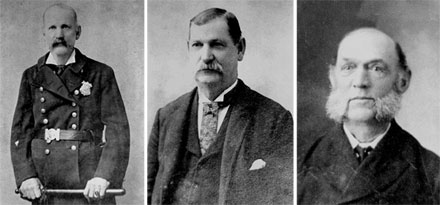| Join | Official Historian | City of Stamford | Blog | About Us | |
| Jewish Historical Society | Civil War Roundtable | Contact Us | |
|
|
|
|
The Stamford Historical Society PresentsLaw & Order: The
History of the Stamford Police Department 1830-1956
|
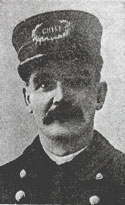 |
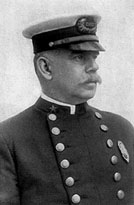 |
| George Bowman | William H. Brennan |
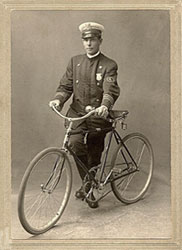 Initially, appointments within the police department were made for only a
year at a time and many failed to be reappointed. During the administration
of Homer S. Cummings in 1901 the salary of the Chief was fixed at $1200/year
and patrolmen's salaries were graded and ranged from $50-60/month.
Initially, appointments within the police department were made for only a
year at a time and many failed to be reappointed. During the administration
of Homer S. Cummings in 1901 the salary of the Chief was fixed at $1200/year
and patrolmen's salaries were graded and ranged from $50-60/month.
The first bicycled policeman was Arnold Kurth in 1894. He came from Cologne, Germany. He worked as an iceman on Cove Pond, then became the “Boy Cop,” wearing Police Badge #1 until he retired.
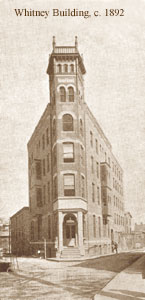 The first
police headquarters was established on May 12, 1894 in the Whitney Building
at Canal and Atlantic Streets. The department remained there for two years,
moving on July 31, 1896 to the Quintard Building in Atlantic Square . On
April 1, 1907 , the department was moved to Bank Street in the Town
Hall with the Detective Bureau (established June 1909 through an
amendment to the City Charter) housed separately directly across the street
at 51 Bank Street . The Bureau's first detective was James J. Heffernan,
who was also the acting dog warden. The Detective Bureau was originally
made up of two men but grew steadily. The Detective Bureau was moved out
in 1946.
The first
police headquarters was established on May 12, 1894 in the Whitney Building
at Canal and Atlantic Streets. The department remained there for two years,
moving on July 31, 1896 to the Quintard Building in Atlantic Square . On
April 1, 1907 , the department was moved to Bank Street in the Town
Hall with the Detective Bureau (established June 1909 through an
amendment to the City Charter) housed separately directly across the street
at 51 Bank Street . The Bureau's first detective was James J. Heffernan,
who was also the acting dog warden. The Detective Bureau was originally
made up of two men but grew steadily. The Detective Bureau was moved out
in 1946.
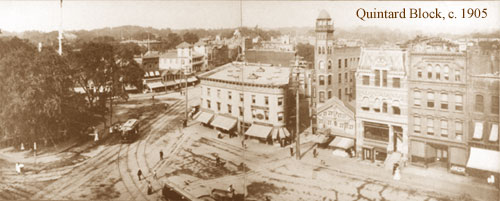
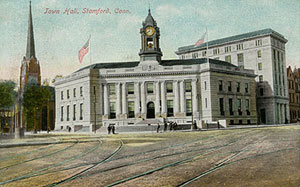 By 1909 the Stamford Police department had grown to the point that it was
as large as any for a city the size of Stamford . Chief William H. Brennan
presided over a total of 20 men including two sergeants, a detective sergeant,
an acting detective/dog warden, a driver for the police wagon and ambulance,
and 14 patrolmen. An additional 30 men were contracted as special policemen
to be called upon as needed. The police had for some time been stationed at
the Town Hall building with separate departments for male and female prisoners
and each having its own cell. Records and materials were kept in the Chief's
private office on the first floor. Index cards were in use to ease the use
of records.
By 1909 the Stamford Police department had grown to the point that it was
as large as any for a city the size of Stamford . Chief William H. Brennan
presided over a total of 20 men including two sergeants, a detective sergeant,
an acting detective/dog warden, a driver for the police wagon and ambulance,
and 14 patrolmen. An additional 30 men were contracted as special policemen
to be called upon as needed. The police had for some time been stationed at
the Town Hall building with separate departments for male and female prisoners
and each having its own cell. Records and materials were kept in the Chief's
private office on the first floor. Index cards were in use to ease the use
of records.
A rogue's gallery was also established, the Bertillion system of fingerprinting and identification, an innovation of its day, Stamford Police started using it in 1907. The detective bureau was located on the next upper floor with its own records and photo archive. The Sergeants' office was on the ground floor entered from Bank Street.
In terms of technology the police relied on a telephone system, consisting of 17 call boxes located at different locations throughout the city and linked to police headquarters. The police maintained two new vehicles, an ambulance and a patrol wagon, both horse drawn. The single police horse was taken care of by the driver.

Patrolmen worked in three shifts of eight hours each. Sergeants worked 11 hour days while the Chief, detectives and driver were virtually always on duty or on call. Uniform firearms were introduced in 1909 as well. The department covered the City which was that area below Bull's Head.
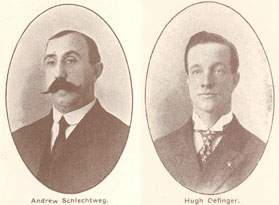 Town constables
continued to play a role along side the police in apprehending criminals
and also in the performance of detective duty. The constables were elected
for two year terms. Two of the most notable in 1909 were Andrew Schlechtweg
and Hugh Oefinger. Schlechtweg was a Stamford native who by 1909 had served
as a constable for 18 years. His private detective agency Schlechtweg & Oefinger
held the state record for apprehending horse thieves. Oefinger, also a Stamford
native, had by 1909 served as constable for nine consecutive years and was
Schlechtweg's business partner.
Town constables
continued to play a role along side the police in apprehending criminals
and also in the performance of detective duty. The constables were elected
for two year terms. Two of the most notable in 1909 were Andrew Schlechtweg
and Hugh Oefinger. Schlechtweg was a Stamford native who by 1909 had served
as a constable for 18 years. His private detective agency Schlechtweg & Oefinger
held the state record for apprehending horse thieves. Oefinger, also a Stamford
native, had by 1909 served as constable for nine consecutive years and was
Schlechtweg's business partner.
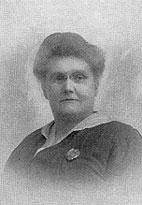 Stamford got its first police matron in February 1911. Her name was Seraphina
Klahre and she doubled as secretary to Chief William H. Brennan.
Stamford got its first police matron in February 1911. Her name was Seraphina
Klahre and she doubled as secretary to Chief William H. Brennan.
Following the short tenure of James Heffernan as Chief (1923-1926), John B. Brennan was appointed (1926-54). This Chief Brennan had been appointed to the department March 11, 1914 and was one of the city's first bicycle policemen. He was elevated to Captain June 10, 1919 and succeeded Heffernan March 8, 1926 . Aides of Chief Brennan in the management of police department affairs were Capt. Martin C. Ryan, who was first named to the department in 1905, and Walter Faubel, a member of the department since 1917. Other department officers included three desk sergeants, three street sergeants, and a traffic sergeant. By 1941 the Board of Public Safety created by the Connecticut State Legislature made appointments formerly controlled by the Common Council. Joseph W. Kinsella succeeded Brennan occupying the Chief's chair until Feb. 1, 1977.
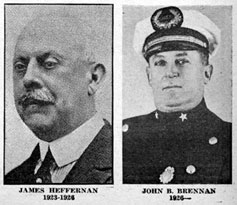 By 1929 Stamford was linked with 14 other police departments and the State
DMV in the police telegraph typewriter system.
By 1929 Stamford was linked with 14 other police departments and the State
DMV in the police telegraph typewriter system.
From the time of its inception, the Detective Bureau maintained an active file of all cases under investigation. A special card index system was inaugurated in 1934, so that all automobile accidents could be classified. This file was under the direction of the Safety Officer and was used by all members of the department A complete fingerprint file was also maintained. A photo archive of shots taken at the scene of the crime was also on file.
By 1941 Stamford 's Police department included 72 patrolmen and 20 officers. By 1946 the department had continued to grow the total force comprised of a Chief, two Captains, one in the uniform division and one in the Detective division, a Lieutenant in the uniform division, nine detective sergeants, three desk sergeants, one traffic maintenance sergeant, four street sergeants, and 85 patrolmen—13 of them served in the armed forces during WWII—and a Police Matron to care for women prisoners. The police department was still based primarily on the ground floor of the old Town hall despite attempts to acquire an alternate site for the department. In 1916, the Board of Finance refused to approve a project to acquire a site on West Park Place . Later in the 1930s, during the tenure of mayor Alfred N. Phillips Jr., another project to build a new police headquarter on Elm Street was defeated. In November of 1951 the police department had taken over the third floor of the Central Fire Station on Haig Ave. It stayed there till the new building was completed. In August of 1956 the Police moved to their current location at the intersection of Bedford Street and Hoyt Street extension.
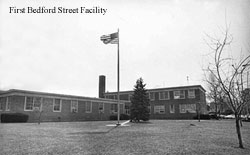 Also by 1941,
salaries had risen considerably from 1901, with Chief John Brennan receiving
$4500/year and first-grade patrolmen receiving $45/week. Patrolmen were
selected from the supernumerary list and were eligible for retirement aftert
25 years with a pension.
Also by 1941,
salaries had risen considerably from 1901, with Chief John Brennan receiving
$4500/year and first-grade patrolmen receiving $45/week. Patrolmen were
selected from the supernumerary list and were eligible for retirement aftert
25 years with a pension.
Around 1940 communications within the department were improved through the installation of a three-way radio system that allowed patrol cars to keep in instant contact with headquarters at all times. There were by then eight radio-equipped cars in city service and two in the town department , where an organized police department had been started in 1925. The adoption of radio also made it necessary to increase the members of the departments. Six men on the city force had this duty and two on the town force.
In 1946 there were 6 cars equipped with radios, 5 of which were used 24 hours a day on patrol work in all sections of the city. Five additional cars had been ordered for patrol work as well. There were 3 other cars that were not equipped with radio that were used for investigations, a combination patrol wagon and ambulance and 5 motorcycles. The motorcycle patrol operated between 8 AM and darkness, weather permitting. By 1951 the police department acquired two Safety Patrol cars equipped with collapsible stretcher, resuscitator, fire extinguishers and first aid equipment.
Also in 1946, Traffic Policemen were detailed between the hours of 7 AM and 11 PM at strategic points in the center of the city, while several street intersections were controlled by a system of traffic lights.
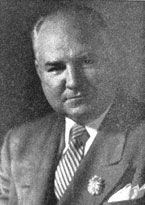 |
By 1946 the police department was equipped to handle all lines of investigations. A complete fingerprinting and photographic file was maintained by the department in charge of a Fingerprint expert and Photographer, who cooperated with the FBI, filing all fingerprints in Washington D.C. Department members were also all trained by the Red Cross in First Aid so as to be ready for any emergency. Each of the radio cars were equipped with first aid equipment as well.
Town Police
The Town Police were begun in 1925 by first selectmen Andrew Schlechtweg to address the many complaints coming in from people who lived outside city limits about speeding autos. A special constable was appointed to do patrol work on a motorcycle. By 1941 the Town Police force had grown to seven men and three officers.
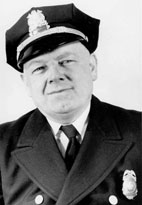 |
Initially the force rode motorcycles, while others patrolled via the trolley up and down Hope Street and it was not until 1936 that it received cars. On Feb. 1, 1937 Third Selectman Frank E. McMahon became chief of the town department When McMahon left in 1941 Ed Lockwood was left in charge. By 1941 the town department had seven patrolmen and three officers and had two radio-equipped patrol cars.
The town department first had an office in the Springdale fire house and later was at the Springdale Rolling Mills. The guard at the Rolling Mills took messages from downtown for the officers and alerted them of a message by lighting a light out near the corner of Hope and Rolling Place . In 1941, the department head quarter was located on Haig Ave. , where a two story stone building was completed by the WPA. The town police department was equipped with a 3 way radio system and a 24 hour patrol was maintained throughout the territory outside city limits. In 1949 The Town Police Department became part of the City Police Department with the consolidation of town and city.
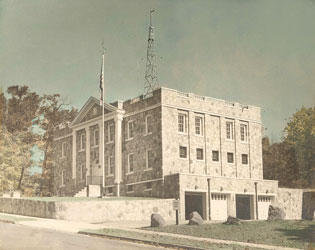 |
Photos © Stamford Historical Society, William Lockwood (2)
back to top